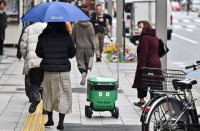RATCHABURI, Thailand – The El Nino weather phenomenon has played havoc with crops across Southeast Asia and beyond. Thailand, the world’s second-largest sugar exporter, will ship 20 percent less of the sweetener to international markets this year than last, and farmers fear the damage already inflicted on young cane plants could make the situation even worse next year.
A drop in exports from Thailand and India has contributed to forecasts for a widening global supply deficit this year, fueling a rally in international prices to a 17-month peak last week and helping sugar outperform a commodity complex struggling with the slump in global oil prices.
Local sugar cane farmer Prasert Jitkham, 60, stoops down and pulls a yellowed sugar cane shoot from baked soil. The worst drought in more than twenty years in Thailand has killed the plant he should have been able to harvest next year.
“The drought has resulted in the crops not growing, allowing the pests to eat all its roots. There’s no rain to help the roots grow, so the sugar cane cannot grow to its potential (height),” he told Reuters.
International prices may have rallied but Thai farmers are reaping no benefits. Prasert and other sugar farmers in the central Thai province of Ratchaburi say they have lost 20-30 percent of their output this year due to the drought.
Dry conditions make cane less sweet, so refiners need more cane to produce the same amount of sugar. That means they pay farmers less per tonne.
As the drought takes its toll on the young cane, farmers, sugar mills and the government have soured on their outlook for next year’s crop.
“I think it will be worse next year. With this kind of weather of 40 degrees and no rain, the sugar cane cannot survive. Eighty percent of the crop was damaged and for next year, I think it will be worse,” said 38-year old sugar cane farmer Kamol Krataithong.
With cane output down, sugar refineries are operating well below capacity.
Banpong sugar mill, a mid-sized plant in Ratchaburi, will run for only 90 days, 25 percent below its capacity 120 days, said manager Prasong Ruenthong. The plant can process up to 14,000 tonnes of cane per day.
“No, the sugar supply is not enough for export. We have a huge quota for export but we do not have enough supply to meet the target. We’re still missing about 300,000 tons of sugar cane to produce sugar,” he said.
The drought was so bad that even irrigated fields could soon face problems as water levels were so low in canals and reservoirs, he added.
Thai sugar cane output is expected to fall below 95 million tonnes both this year and next, he said. That was down from 105.95 million tonnes in 2014/2015.
Thailand, which typically exports about three quarters of its sugar output, will ship out about 7.1 million tonnes in 2015/16, down from 8.9 million tonnes a year ago.
Sugar has rebounded from seven-year lows touched last August on concerns over supply from Asia, and similar Thai export volumes next year may prolong the tighter outlook for global fundamentals.
As farmers get a lower yield from a smaller crop, more of them are getting into debt.
Of 400 farmers who sell their harvest to Prasong’s refinery, 30 have for the first time failed to repay loans administered by the refinery for the crop year.
They are part of a growing number of Thailand’s rural population struggling with debt. Most are rice farmers who were hit hard when the military seized power in 2014 and ended generous subsidies.
The irony for some in Ratchaburi is that they have taken a double hit – they were encouraged to convert to sugar from rice as the junta sought to cut subsidy reliance and reduce massive rice stocks.







